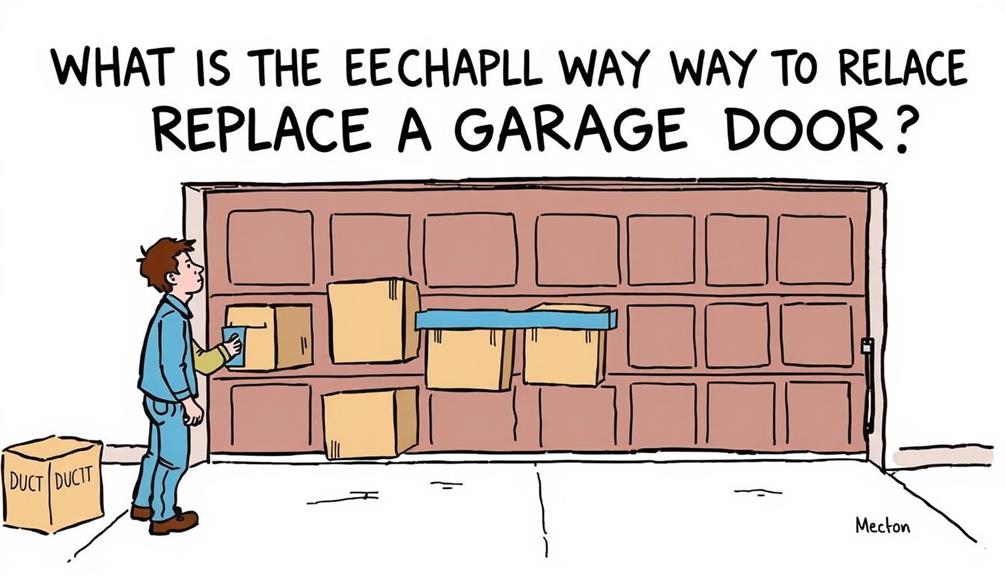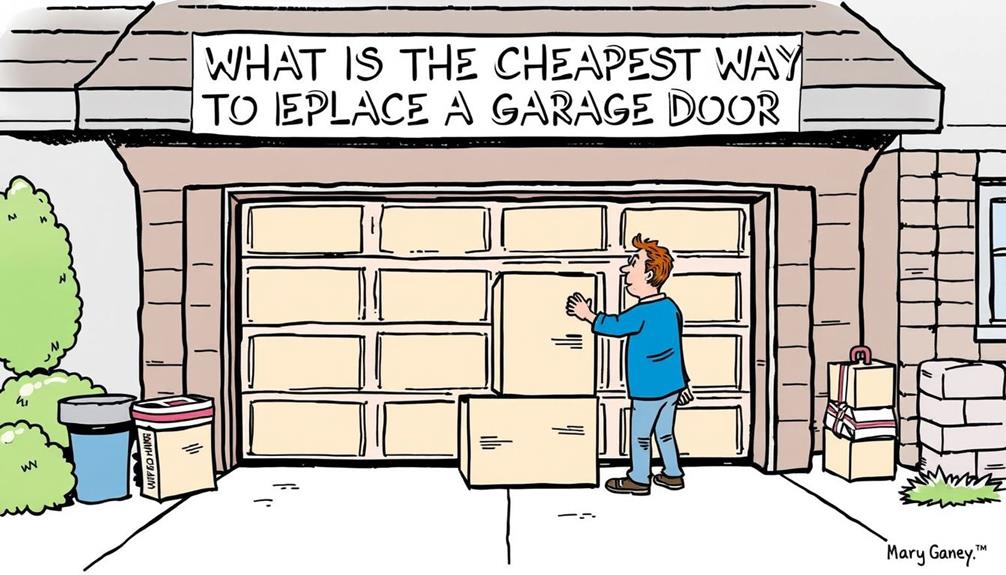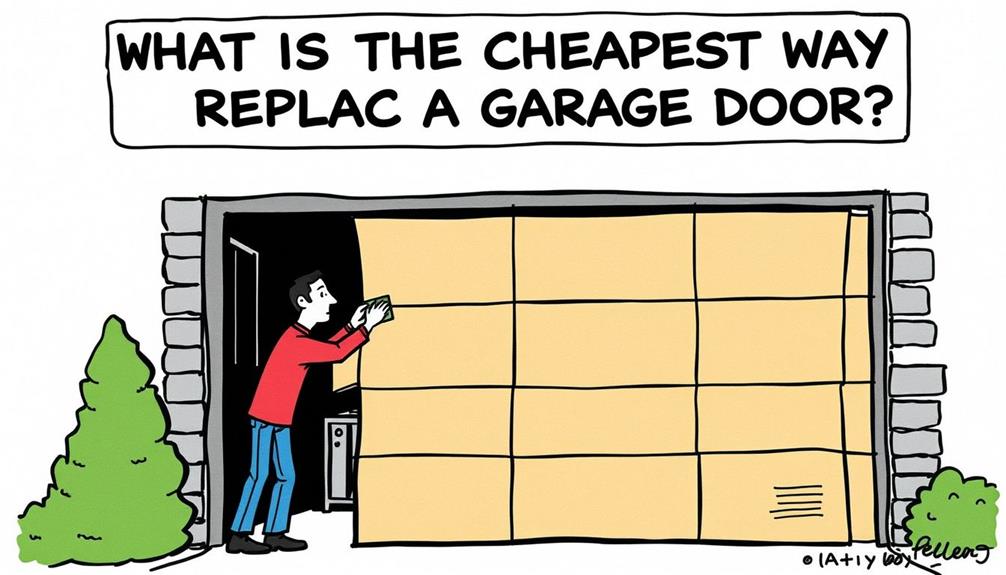
What Is the Cheapest Way to Replace a Garage Door?
The cheapest way to replace a garage door is through DIY installation and careful material selection. You'll save considerably on labor costs by installing the door yourself, but guarantee you have the necessary skills and tools. Consider cost-effective materials like steel or aluminum, which offer durability and affordability. If your existing door is in decent condition, refurbishing it with fresh paint, new hardware, and minor repairs can be a budget-friendly alternative. When opting for DIY installation, watch tutorial videos, gather the right tools, and enlist help from friends to certify a safe and successful project. Exploring these options can lead to substantial savings while improving your home's functionality and appearance.
Cheapest Garage Door Replacement

When considering the cheapest way to replace your garage door, you'll need to weigh several factors. First, compare the costs of DIY installation versus hiring a professional. Consider the risks and potential disasters associated with DIY garage door repairs, such as improper installation leading to a garage door being stuck open. Further, take into account your skill level and the potential for costly mistakes.
Next, research different material options, such as steel, aluminum, or wood, to find the most cost-effective solution that meets your needs and climate requirements. Finally, don't overlook the possibility of refurbishing your existing door, which could involve repainting, replacing damaged panels, or upgrading hardware for a fraction of the cost of a full replacement.
DIY Vs. Professional Installation
Garage door replacement presents a choice between do-it-yourself installation and professional services. When considering DIY installation, you'll need to assess your skill level, available time, and necessary tools. This option can save you money on labor costs, but it requires careful planning and execution. You'll need to accurately measure the door opening, select the right materials, and follow manufacturer instructions meticulously. Are you comfortable working with heavy components and electrical systems?
Professional installation, while more expensive, offers several advantages. Trained technicians bring expertise, specialized tools, and experience to guarantee proper fit and function. They can handle unexpected complications, such as uneven floors or damaged framing. Additionally, professional installers often provide warranties on their work, giving you peace of mind. Consider the complexity of your garage door system: does it include advanced features like smart home integration or high-lift tracks? These may necessitate professional installation.
Ultimately, your decision should balance cost savings against potential risks and long-term reliability. If you're confident in your abilities and have a straightforward replacement, DIY might be suitable. However, for complex systems or if you value assured results, professional installation could be the wiser choice.
Material Cost Comparison
A key factor in finding the cheapest garage door replacement is comparing material costs. Steel doors, typically the most affordable option, range from $300 to $1,000, depending on insulation and gauge. Aluminum doors, slightly more expensive, offer rust resistance and start at around $500. Wood doors, while aesthetically pleasing, can cost between $800 and $3,000, making them less budget-friendly.
When comparing materials, consider long-term costs as well. How will the door's insulation affect your energy bills? Will the material require frequent maintenance or repairs? For instance, steel doors are low-maintenance but may dent easily, while wood doors need regular upkeep to prevent warping and rotting.
Don't overlook composite materials, which can offer a balance between cost and durability. These doors, made from recycled wood fibers and plastic, typically range from $800 to $2,000. While more expensive upfront, they often require less maintenance than wood and can withstand harsh weather conditions better than steel or aluminum. When making your decision, weigh the initial cost against potential long-term savings to determine the most cost-effective option for your specific needs.
Refurbish Existing Door
The cheapest garage door makeover often involves refurbishing your existing door. This approach can greatly reduce costs while breathing new life into your garage's appearance. To begin, assess your door's condition, looking for structural issues, rust, or damaged panels. If the frame and mechanics are sound, you can focus on cosmetic improvements.
Start by thoroughly cleaning the door, removing dirt, grime, and any flaking paint. Next, sand the surface to create a smooth base for new paint or stain. Are there dents or minor damage? Consider using auto body filler to repair these imperfections. Once you've addressed surface issues, apply a primer and high-quality exterior paint or stain designed for garage doors. Don't forget to update hardware, such as handles and hinges, which can dramatically enhance the door's appearance. You might also consider adding insulation to improve energy efficiency. Can you upgrade the windows? New glass inserts or decorative overlays can transform the door's look. Finally, lubricate moving parts and tighten any loose bolts to guarantee smooth operation. By refurbishing your existing door, you'll achieve a fresh look without the hefty price tag of a full replacement.
Benefits

Replacing your garage door with a more affordable option can yield several significant benefits. Specifically, preventive maintenance can guarantee your door's durability and longevity, consequently maximizing the return on your investment.
You'll experience immediate cost savings on the installation, while also potentially improving your home's energy efficiency through better insulation, which can lead to lower heating and cooling bills. Furthermore, if you encounter any issues, professional technicians are available for emergency repair.
In addition, a new garage door can enhance your home's curb appeal and value, while often incorporating advanced safety features that protect your family and belongings.
Cost Savings
Three key benefits make replacing your garage door the cheapest way a smart financial decision. First, you'll greatly reduce your energy costs. A new, insulated garage door will help maintain a consistent temperature in your garage, reducing the strain on your HVAC system and lowering your utility bills.
Second, you'll avoid costly repairs in the future. By replacing an old, worn-out door now, you're preventing potential breakdowns that could lead to expensive emergency repairs or replacements down the line.
Lastly, you'll increase your home's value. A new garage door offers an excellent return on investment, often recouping up to 94% of its cost in added home value. This makes it one of the most cost-effective home improvement projects you can undertake.
When considering replacement options, factor in long-term durability and energy efficiency. While a steel door may have a higher upfront cost than a wooden one, its longevity and insulation properties could save you more money over time. Have you considered how these cost savings could impact your household budget? By choosing the cheapest way to replace your garage door, you're making a wise investment in your home's future.
Improved Energy Efficiency
Energy efficiency stands out as a major benefit when replacing your garage door the cheapest way possible. By opting for a new, insulated door, you'll significantly reduce heat transfer between your garage and the outdoors. This improved thermal barrier can lead to lower energy bills, especially if your garage is attached to your home or if you use the space frequently.
When selecting a budget-friendly garage door with energy efficiency in mind, look for models with a high R-value, which indicates better insulation properties. Polyurethane foam-filled doors typically offer superior insulation compared to polystyrene options. Additionally, consider weatherstripping along the door's edges to further minimize air leakage.
How does this impact your home's overall energy consumption? A well-insulated garage door can help maintain a more consistent temperature in adjacent living spaces, reducing the workload on your HVAC system.
Don't overlook the importance of proper installation, as even the most energy-efficient door won't perform ideally if gaps or misalignments exist. By prioritizing energy efficiency in your garage door replacement, you're not only saving money upfront but also investing in long-term energy savings and improved comfort for your home.
Enhanced Home Value
A new garage door can markedly boost your home's value, making it a smart investment even when you're on a budget. Real estate experts often cite curb appeal as a pivotal factor in property valuation, and your garage door typically accounts for a significant portion of your home's facade. By replacing an outdated or damaged door with a modern, aesthetically pleasing option, you're not only improving functionality but also enhancing your property's overall appearance.
When selecting a replacement door, consider styles that complement your home's architecture. For instance, carriage house doors can add charm to traditional homes, while sleek, minimalist designs suit contemporary structures. Materials also play a role in value enhancement; while steel doors offer durability and cost-effectiveness, wood doors provide a high-end look that can command premium prices.
Have you thought about how window inserts might brighten your garage's interior? This feature can be particularly appealing to potential buyers. Additionally, smart garage door openers with smartphone integration can be a selling point, showcasing your home's modern conveniences. Remember, while opting for the cheapest replacement might save money upfront, investing in quality can yield higher returns when it's time to sell your property.
Increased Safety Features
Modern garage doors come equipped with numerous safety features that greatly enhance your home's security and protect your family. When replacing your garage door, you'll benefit from advanced technologies that weren't available in older models. These include auto-reverse mechanisms, which prevent the door from closing if an object or person is detected underneath, and photo-eye sensors that create an invisible beam across the door's opening to detect obstructions.
You'll also find that new garage doors often come with rolling code technology for remote controls, making it nearly impossible for potential intruders to hack or replicate your door's unique access code. Many models now offer smartphone integration, allowing you to monitor and control your garage door remotely. This feature enables you to check if you've left the door open or grant temporary access to visitors or service providers.
Additionally, improved locking mechanisms and reinforced panels provide better resistance against forced entry attempts. Some doors even incorporate impact-resistant materials, offering protection against severe weather conditions. Have you considered how these safety upgrades could provide peace of mind for your household? When selecting a new garage door, prioritize these enhanced safety features to maximize both security and functionality.
Cost-Saving DIY Installation Tips

To save money on your garage door replacement, consider a DIY installation approach. You'll need to gather the necessary tools and equipment before starting the project. Watching tutorial videos and recruiting friends to help can make the process smoother and more efficient, potentially saving you hundreds of dollars in labor costs.
| Tool | Purpose |
|---|---|
| Ladder | Reaching upper sections |
| Socket wrench set | Removing old hardware |
| Power drill | Installing new hardware |
| Level | Ensuring proper alignment |
| Safety glasses | Protecting your eyes |
Gather Necessary Tools
Before diving into the installation process, you'll need to gather the right tools for the job. Essential items include a power drill with various bits, a socket wrench set, pliers, a level, a tape measure, and a sturdy ladder. You'll also require safety equipment like work gloves and protective eyewear. Don't forget a few helpers, as garage doors are heavy and unwieldy.
For removing the old door, you might need a pry bar and hammer. If you're working with a wooden door, have a circular saw on hand for potential adjustments.
Are you installing a pre-hung door? In that case, you'll want shims and a caulk gun for proper fitting. For metal doors, consider having tin snips available.
Watch Tutorial Videos
Armed with your tools, the next step is to watch tutorial videos on garage door installation. These videos can provide invaluable guidance, helping you understand the process step-by-step and potentially saving you thousands in professional installation costs.
Look for tutorials from reputable sources, such as garage door manufacturers or experienced DIY enthusiasts, to guarantee you're getting accurate information.
As you watch, pay close attention to safety precautions, as garage doors can be dangerous if not handled properly. Take note of specific techniques for removing the old door, installing tracks, and properly tensioning the torsion springs.
How do the experts position the panels? What methods do they use to make sure the door is level and balanced?
Don't hesitate to replay sections that seem complex or unclear. It's essential to fully grasp each step before attempting the installation yourself. While watching, create a checklist of key points and potential challenges you might face during the process.
This preparation will help you anticipate issues and work more efficiently when you begin the actual installation, further reducing costs by minimizing mistakes and wasted materials.
Recruit Helpful Friends
Recognizing the complexity of garage door installation, it's wise to recruit a few helpful friends for the project. Having extra hands can substantially reduce the time and effort required, while also enhancing safety during the process. When selecting your team, consider individuals with mechanical aptitude or prior experience in home improvement projects.
Before your friends arrive, make certain you've gathered all necessary tools and materials. Have you prepared a detailed plan of action? It's vital to assign specific roles to each person, such as managing the torsion spring system, aligning the tracks, or handling the door panels. Remember, proper coordination is key to a smooth installation process.
Safety should be your top priority. Instruct your helpers on the potential hazards, such as pinch points and the dangers of working with high-tension springs. Provide appropriate personal protective equipment, including gloves and safety glasses. As you work through the installation, communicate clearly and frequently. Don't hesitate to consult the manufacturer's instructions or online resources if you encounter any challenges. By leveraging the skills and support of your friends, you can successfully complete your garage door replacement while keeping costs to a minimum.
Frequently Asked Questions
How Long Does a Typical Garage Door Replacement Take?
You can expect a typical garage door replacement to take 3-6 hours. It'll depend on the door's complexity and any additional features. Professional installers can usually complete the job in a single day, minimizing disruption to your routine.
Can I Reuse My Existing Garage Door Opener With a New Door?
You can often reuse your existing garage door opener with a new door. However, you'll need to guarantee compatibility with the door's weight and style. It's best to consult a professional to validate if it's suitable for your new installation.
What Are Signs That Indicate My Garage Door Needs Replacement?
You'll notice signs your garage door needs replacement: frequent breakdowns, visible damage, excessive noise, and difficulty opening or closing. Watch for sagging, rust, or outdated safety features. If it's over 20 years old, consider upgrading.
Are There Financing Options Available for Garage Door Replacements?
Yes, you'll find various financing options for garage door replacements. You can explore home improvement loans, credit cards, or manufacturer financing. Some companies offer in-house payment plans too. Always compare interest rates and terms before deciding on an option.
How Often Should Garage Doors Be Maintained to Prevent Premature Replacement?
You should maintain your garage door at least twice a year. Lubricate moving parts, tighten hardware, and check for wear. Regular inspections can catch minor issues before they become major problems, extending your door's lifespan and avoiding early replacement.





